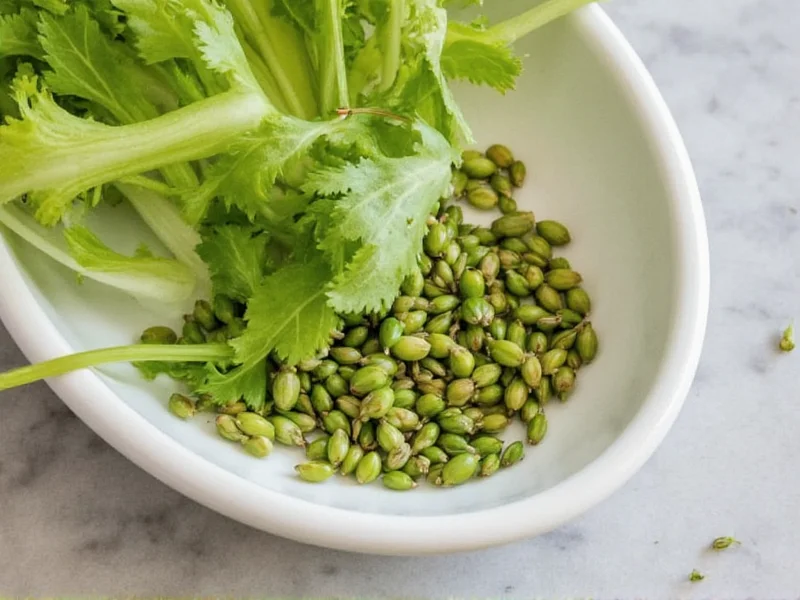Celery seeds (Apium graveolens) offer versatile applications that extend far beyond their small size suggests. Unlike celery stalks, these tiny brown seeds concentrate potent essential oils and bioactive compounds, making them valuable across culinary, medicinal, and traditional domains. Understanding the proper uses of celery seeds helps maximize their benefits while avoiding potential risks.
Culinary Applications of Celery Seeds
Chefs and home cooks prize celery seeds for their intense, earthy flavor that enhances numerous dishes. The seeds contain higher concentrations of apiol and other essential oils than celery stalks, delivering a more robust taste profile. When using celery seeds in cooking, remember they're significantly more potent than fresh celery, so a little goes a long way.
| Culinary Use | Recommended Amount | Best Pairings |
|---|---|---|
| Salad dressings | 1/4 teaspoon per cup | Vinaigrettes, coleslaw, potato salad |
| Bread and baking | 1/2 teaspoon per loaf | Rye bread, crackers, savory muffins |
| Pickling and preserving | 1 teaspoon per quart | Cucumbers, onions, mixed vegetables |
| Meat rubs and marinades | 1 teaspoon per pound | Poultry, fish, lean meats |
Professional chefs often toast celery seeds lightly before use to enhance their aromatic compounds. This simple technique unlocks deeper flavors that work particularly well in Mediterranean and Eastern European cuisines. When substituting for fresh celery, use approximately 1/8 teaspoon of seeds for each stalk required in your recipe.
Medicinal Properties and Health Benefits
Traditional medicine systems worldwide have utilized celery seeds for centuries, and modern research supports several potential health applications. The seeds contain concentrated levels of apiol, limonene, and other phytochemicals that contribute to their therapeutic properties.
Studies indicate celery seeds may support digestive health by stimulating bile production and reducing intestinal spasms. Many people use celery seed tea as a natural remedy for bloating and gas. The seeds' anti-inflammatory compounds, particularly luteolin, show promise in managing mild joint discomfort when consumed regularly in appropriate amounts.
Research published in the Journal of Medicinal Food suggests celery seeds possess antioxidant properties that may help protect cells from oxidative stress. While not a substitute for medical treatment, incorporating moderate amounts of celery seeds into your diet may contribute to overall wellness when used as part of a balanced approach to health.
Traditional Remedies and Home Applications
Across various cultures, celery seeds have served as home remedies for common ailments. Traditional European herbalists frequently recommended celery seed preparations for supporting kidney function and promoting healthy fluid balance. In Ayurvedic medicine, practitioners have used celery seeds to address occasional sleep disturbances and mild anxiety.
Creating celery seed tea represents one of the simplest home applications. Steep one teaspoon of crushed seeds in hot water for 10-15 minutes, then strain. This preparation may provide digestive support after meals. Some people add honey and lemon to improve the somewhat bitter taste.
For topical applications, crushed celery seeds mixed with carrier oil create a traditional preparation for temporary relief of minor muscle discomfort. However, always perform a patch test first, as some individuals may experience skin sensitivity to celery seed oil.
Safety Considerations and Proper Usage
While celery seeds offer numerous potential benefits, proper usage requires attention to dosage and individual sensitivities. The concentrated compounds that provide benefits can cause adverse reactions in some people, particularly when consumed in large amounts.
Pregnant women should avoid medicinal amounts of celery seeds, as high concentrations may stimulate uterine activity. Individuals with celery allergies should completely avoid celery seeds, as they contain higher concentrations of allergenic compounds than celery stalks.
The appropriate culinary amount for most adults ranges from 1/4 to 1 teaspoon daily. For medicinal purposes, consult a healthcare provider before regular use, especially if taking blood thinners or diuretic medications, as celery seeds may interact with these drugs.
Storage and Preservation Techniques
Proper storage maintains the potency and flavor of celery seeds. Store them in an airtight container away from light and heat to preserve their essential oils. When kept correctly, whole celery seeds retain their flavor for up to two years, while ground seeds maintain quality for about six months.
For long-term storage, consider keeping celery seeds in the refrigerator or freezer. This practice particularly benefits those who use celery seeds medicinally, as it preserves the delicate compounds responsible for their therapeutic properties. Always allow refrigerated seeds to reach room temperature before opening the container to prevent moisture condensation.











 浙公网安备
33010002000092号
浙公网安备
33010002000092号 浙B2-20120091-4
浙B2-20120091-4